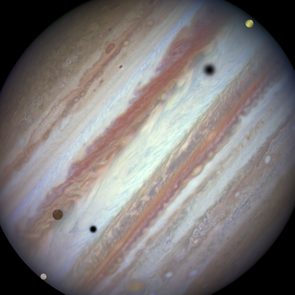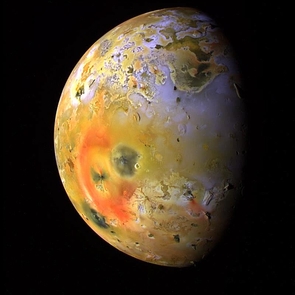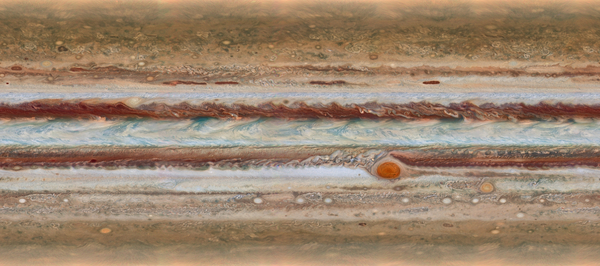JUICE's secondary target: the Jupiter system
 |
 |
| Jupiter and three of its largest moons. Credit: NASA, ESA, Hubble Heritage Team |
Surface changes on Io. Credit: NASA/JPL/University of Arizona |
Volcanic Io
While JUICE's focus is on the icy moons, the mission will also gather information about the innermost Galilean satellite, Io, the most volcanically active object in our Solar System. At Io, the inward gravitational pull from Jupiter and the outward pull from the other Galilean moons results in intense tidal heating, which drives the moon's geological activity. Eruptions from its 400 active volcanoes release lava onto Io's surface, while gases and other substances escape to the moon's thin atmosphere and Jupiter's magnetosphere. JUICE will monitor the volcanic activity of Io and determine the composition of different surface materials.
Inner moons and dusty rings
JUICE will also remotely explore the smaller inner moons of Jupiter and its faint, dusty rings. Metis, Adrastea, Amalthea, and Thebe orbit the gas giant from about 127 000 kilometres to 222 000 kilometres, respectively, passing through Jupiter's ring system. Dust ejected by these small satellites is believed to provide the material in the rings, though the exact composition and age of the system is unknown. Another uncertainty is how the dust in the rings is replenished: due to the violent processes at Jupiter, which remove small particles, the tenuous ring system would not be a long-lived feature without new material regularly being added to it. JUICE will study Jupiter's small inner satellites by investigating their shape and composition and shedding light on how these objects relate to the rings. To find out more about the origin and dynamics of the rings, the mission will also explore their physical properties and chemical composition.
Much of JUICE's focus will also be on Jupiter itself, extending the discoveries made with the Galileo spacecraft and complementing the work of NASA's Juno mission.
An ever-changing atmosphere
JUICE will study Jupiter's complex and ever-changing atmosphere—from the churning clouds of the troposphere up to the high thermosphere—with emphasis on its vertical structure, composition, and the processes that shape it. JUICE's investigations of Jupiter—the archetypical giant planet—will provide new insight into the myriad processes shaping giant planet weather, climate, and atmospheric chemistry, both in our Solar System and beyond.
 |
| Jupiter at a glance. Credit: NASA, ESA, A. Simon (GSFC), M. Wong (UC Berkeley), and G. Orton (JPL-Caltech) |
The lowest part of the atmosphere, the weather layer, is characterised by a complicated system of hazes and clouds. Depending on their opacity, the clouds appear as light zones or dark belts, giving Jupiter its famous banded appearance. JUICE will repeatedly map Jupiter's atmosphere from the equator to the poles to determine the mechanisms responsible for maintaining and regenerating these colourful bands.
JUICE will considerably expand our knowledge of Jupiter's poorly explored middle and upper atmosphere, high above the visible clouds. The suite of remote sensing instruments will reveal the processes that connect the different atmospheric layers together, such as wave propagation and energy transport. JUICE's instruments will measure, for the first time, the winds in the planet's middle atmosphere. The mission will also investigate the composition of the various atmospheric layers and determine how external impacts—from asteroids, or comets such as Shoemaker-Levy 9—influence the atmosphere.
JUICE will reveal how energy is transported within Jupiter's atmosphere, both vertically from the weather layer into the middle and upper atmosphere, and horizontally from the smallest thunderstorms and turbulent eddies to the largest wind jets bordering the belts and zones.
Through close monitoring and tracking of atmospheric processes over time, JUICE hopes to answer questions such as: What mechanisms drive Jupiter's atmospheric circulation and dynamics? How do the various atmospheric processes relate to each other? And how are jets and long-lived storms, such as the Great Red Spot, maintained?
JUICE's comprehensive exploration of Jupiter will give astronomers a global picture of how its atmosphere connects the planet's deep interior to the near-Jupiter space environment, including the Jovian magnetosphere.
Mysterious magnetosphere
Jupiter's magnetosphere—created by the planet's large magnetic field—occupies an extremely vast area around the gas giant and protects it from the solar wind. The region has its own plasma environment, with Io's volcanoes being the main source of plasma. Jupiter's fast rotating magnetic field accelerates particles, creating one of the most intense radiation environments in the Solar System. The complicated interactions between Jupiter's rotation, the planet's magnetic field, the plasma loading from Io, and the solar wind create different regions within the vast magnetosphere. The exact configuration and global dynamics of Jupiter's magnetosphere, and how the diverse plasma environments relate to each other, is one of the outstanding mysteries of our Solar System.
JUICE will explore Jupiter's magnetosphere in unprecedented detail to shed light on the processes occurring within it. It will also probe how Jupiter's magnetic field interacts with the Galilean satellites. While Io is a source of plasma, the icy moons—especially Ganymede and Europa—are plasma sinks with material transported by Jupiter's magnetic field affecting the satellites' composition. The details of these processes, and how much the energetic particles in the magnetosphere affect the composition of the icy moons, are unknown. JUICE aims to unveil these mysteries.
